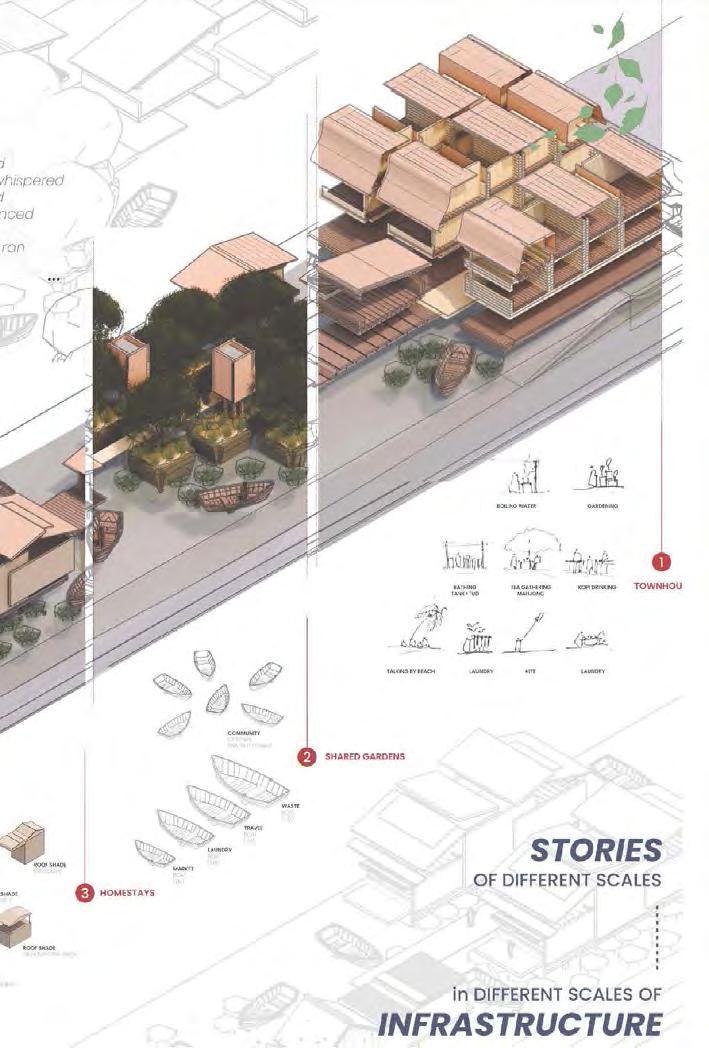




PA_2: Living Closer, Together
PA_3: Creating Community
Summary of Findings Vision


“Jejak Angin Laut”
選擇在印尼語詞語中利用”腳印”來表達 所謂影子,也是因為記憶當中的家鄉 一直是用步行探索的、生活著。這個 詞彙也喚起了我對家鄉的記憶,交銀 與海風交織在一起。廖內城的海屋村 是一個站在海上的村落,從以前都跟 海脫不了關係。利用了暑假的時間, 我也回去體驗了小時候住過的海屋, 也目睹了一個正在快速變化的場景。
廖內城的海屋村曾經充滿了社區生活 的活力,如今面臨著經濟成長緩慢、 基礎設施不足和年輕一代追求其他地 方機會導致人口減少等挑戰。 公共空 間的缺乏和環境的忽視進一步加劇了 人們對社區的疏離和衰退感。
「海風的影子」希望能推測另一種未 來,透過探索海屋村的生活跡象檢討 我們與環境的關係,提供居民一個更 好的生活條件,也同時趁機捕捉家鄉 最珍貴的那些記憶。
「海風的影子」
The Indonesian words “Jejak” and “Angin Laut” evoke the essence of my hometown, Tanjung Pinang, where footprints intertwine with the winds of the sea. In my quest to reconnect with the nostalgia and identity of this coastal village, I embarked on a journey through its waterways during a summer break, witnessing the evolving landscape that was once my childhood.
Tanjung Pinang’s coastal village, once vibrant with community life, now faces the challenges of sluggish economic growth, inadequate infrastructure, and a dwindling population as younger generations seek opportunities elsewhere. The absence of public spaces and environmental neglect further exacerbate the sense of disconnection and decline.
This project endeavors to envision a revitalized future for Tanjung Pinang by delving into the traces of life within the sea village, exploring our relationship with the sea, and advocating for improved living conditions. By reclaiming neglected spaces, fostering community engagement, and embracing sustainable design principles, we can transform Tanjung Pinang into a thriving coastal hub that honors its heritage while embracing progress. At the same time, I am seizing the opportunity to capture the most precious memories of my homeland.
“The sea was right next to us, and the breeze came in through the open doors.”
A Visit Back to My Coastal Hometown
Tanjung Pinang, nestled along the coast of Bintan Island, has a rich maritime heritage dating back centuries. Its identity and livelihood have been intricately tied to the sea, shaping the culture, economy, and way life of its residents.


Relationship to the Sea
“Children can’t play in nor touch the waters anymore.”
Rapid urbanization and lack of infrastructure have since strained the balance between manmade and nature, leading to challenges such as coastal erosion, pollution, and loss of interest to reside near the sea.

In response to these pressing issues, this thesis seeks to explore architectural interventions that reconnect Tanjung Pinang to its maritime roots.





a trip down memory lane


Through various interviews with locals, it is concluded that the remaining inhabitants of the water villages (which is a substantial part of Tj. Pinang’s population), including my family and I, feel the need to preserve our connection with our territory, despite the unsatisfied basic needs and the absence of public policies that promote the care of our habitat.


Coastal architecture encompasses a diverse range of building traditions, materials, and techniques shaped by local climate, geography, and culture. From vernacular



Productive Floating House
Ecuador, 2023, 70 m2
• Wooden truss structure
• Provide modules - services and housing
• Metallic base sturcture with water drums (44 pcs)
• Extending 2m platforms, modular frames every 2m, gable roof and height for ventilation and light


Floating House
Portugal, 2015, 100 m2
• Modularity, mobility
• Transportability of equipment and furniture (2 standard containers)
• Sludge wastewater treatment plan
• Supports outdoor activities

The Floating Island Belgium, 2018
Source: Salty Urbanism methods of inhabiting the sea


ICEBERG Diving Platform
US, 2019, 60 m2
• Walk, rest, reflect, enjoy the canal
• Pontoons, metal frames, deck plates, metal pillars
• Rope curtains to create ambiguous spaces, visualizing wind, and playing with light and shadow
• Diving platform made of wood, flotation barrels, and recycled HDPE tiles
• Annual competition to create an installation for summer camps, built in three weeks, by campers

observations made during one-month stay




The research methodology employed in this project is grounded in a semi-participatory and interdisciplinary approach, combining qualitative and quantitative methods to generate holistic insights into the complexities of reconnecting Tanjung Pinang to the sea. Key research methods include literature review, site analysis, stakeholder interviews, and iterative design prototyping. To further realize the project, it might be wise to hold participatory design workshops in the future.
The design process unfolds through a series of iterative stages, guided by principles of user-centered design, sustainability, and cultural sensitivity. Beginning with a collection of oral stories from the community, the design process progresses through conceptualization, refinement, and implementation planning. Central to this process is the integration of feedback from diverse stakeholders, ensuring that the final design reflects the aspirations, values, and needs of the local community.





weekly calls with Mom back at Tj. Pinang, asking for her opinion and new suggestions
“a
collection of real and imagineries from the past to the present to ththe future.”
Main Problems of the Polluted Waterscape Gradual forgetting of the importance of the sea we share.




In recent years, water pollution is getting worse with less attention being paid to daily waste treatment, and the piling up of past waste. These are also the result of an ignorance, or disregard to the living environment we are surrounded by.

Clean Water Supply and Distances
We live so close to water sources, yet so far too.





Due to lack of proper infrastructure, great reliance on groundwater, as well as the present, tight alleys that are the only roadways paving into the water villages, supplying clean water has been a great challenge in places that have otherwise a very high rainfall rate and a very close distance to the seawater.

For this design, I chose the village where my home is located, called Pelantar Village.



PELANTAR VILLAGE












The objective is to propose a model of water villages that can improve living conditions, starting with the proposal of supporting infrastructure and a series of community-engaging activities that can help clean the sea for the long-term, then propose models of water houses that are improved.






















A survey is conducted of their current living spaces and an inventory is made of existing furniture and their uses.

















from June 2023 to June 2024, this is my attempt to ... capture the memories of my hometown, before it fades away; look back on the architecture of Indonesia, from the lens I have now; start creating, things I wish to make when I return to the lands that once nurtured me.








from June 2023 to June 2024, this is my attempt to ... capture the memories of my hometown, before it fades away; look back on the architecture of Indonesia, from the lens I have now; start creating, things I wish to make when I return to the lands that once nurtured me.

